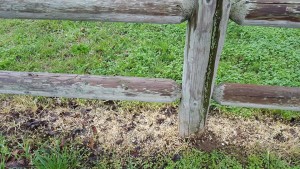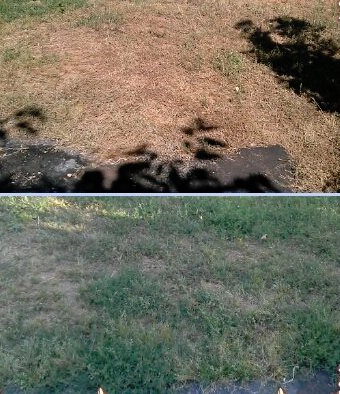Spring is upon us, and the gardening season is right around the corner. Yard work is way overdue in my yard as the heavy rains over the last few weeks have encouraged the grass to “green up” and grow! That is great except where you do not want there to be grass.

This photo was taken by my cousin Brenda Snider. Solution was applied at noon after the dew was gone from the grass. Results were visible in 2 days with yellowing and the grass was fully dead in four days. Vinegar and sodium chloride was also used here.
The top of my yard work “to-do” list is to control the amount of grasses and other light potential wildfire fuel on my property, which means lots of mechanical weed eating and weed pulling.
I have been curious, these last few years, about natural herbicides that might make my weed woes a little easier. I thought that I would test several methods and let you know which worked the best. With this blog, I am just describing the first step – treating some unwanted plants with one of various natural formulations. After a couple of weeks, I will follow up with a description of which treatments actually worked best.
The first method I used was boiling water. That is probably the least harmful to the environment but is a little labor intensive and does use a lot of water. It also will kill anything that it is poured on so try to limit it to the plants that you intend to kill. I recommend using a teapot for this as it is safer than carrying boiling pots of water from your kitchen to your yard, and can target specific plants. I tried this on some persistent non-native vinca and on unwanted grass.
The next method that I tried is Sodium Chloride. (Common table salt.) I mixed about a half cup into a 16 oz. spray bottle with warm water. (This helps to dissolve the salt.) Add a squeeze of dish soap and shake it up well! When spraying the plants, be careful not to spray anything that you want to live. Also, salt can be harmful to soil so you want to be sure to keep the spray on the foliage and don’t overspray.
The third method that I tried was white vinegar. White vinegar sold in the grocery store is 5% acetic acid. Pour the vinegar full strength into a sprayer or squirt bottle. (I prefer a good squirt bottle so that I can control the overspray.) Add a good squirt of dish soap to help it adhere to the leaves. Once again, be careful to only spray the vegetation that you intend to kill. Avoid overspray on soil. This method may take several applications. Garden stores do carry a 20% acetic acid gardening vinegar but this can be harmful to skin, eyes and lungs so use caution.
White vinegar and sodium chloride can be combined to be extra effective. This recipe calls for one cup salt to one gallon vinegar. Mix well so that all of the salt dissolves and does not clog your sprayer. Add a generous squeeze of dish soap again. Once again, you must be careful to spray only the foliage of the plants that you intend to kill. Over-spraying can cause drips and adding anything to your soil will alter it.
20 Mule Team Borax is another alternative. 10 Ounces mixed with 2.5 gallons of water and added to a sprayer. As always, keep it on the foliage and out of the soil.
Dirt is something that you sweep up in your house. Soil is full of life. Organisms that are needed to break down organic matter can be affected by anything that you add to the soil. So with all of these methods I recommend using care to avoid over-spraying whatever formula you are using in order to avoid altering your soil.
My perspective is that it is important to keep toxic herbicides out of our watersheds on a grand scale, but you can also do your part in your own small landscape by minimizing or totally avoiding the use of toxic herbicide formulations.
Check back in a couple of weeks for part two and the exciting results of my trial!

This was taken 24 hours after the vinegar/sodium chloride recipe was applied.
Photo courtesy of Debra Dansky Pierce. Best results were achieved when solution was applied early in the morning on a sunny day. This helped the grass to dry out even faster.
For those of you wanting to know more about non-toxic herbicides, here is my source for the vegetation treatment recipes discussed above:
Tree Hugger Non-toxic Herbicide Recipes
If insects bug you, check out these organic pesticides that will make vegetable-eating bugs think twice before nibbling your garden:
Click here for information on organic pesticide recipes.
Controlling pests with predatory insects can be a great way to naturally control aphids and other hungry insects that may have their eye on your garden. This website is full of information on how to encourage beneficial insects into your garden.
Click here to learn more about beneficial insects!

